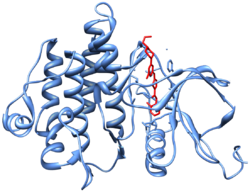Dasatinib
[3] Severe adverse effects may include bleeding, pulmonary edema, heart failure, and prolonged QT syndrome.[5] In the EU dasatinib is indicated for children with and adults with The most common side effects are infection, suppression of the bone marrow (decreasing numbers of leukocytes, erythrocytes, and thrombocytes),[6] headache, hemorrhage (bleeding), pleural effusion (fluid around the lungs), dyspnea (difficulty breathing), diarrhea, vomiting, nausea (feeling sick), abdominal pain (belly ache), skin rash, musculoskeletal pain, tiredness, swelling in the legs and arms and in the face, fever.A small number of people developed abnormal liver function tests which returned to normal without dose adjustments.[8] On October 11, 2011, the U.S. Food and Drug Administration (FDA) announced that dasatinib may increase the risk of a rare but serious condition in which there is abnormally high blood pressure in the arteries of the lungs (pulmonary hypertension, PAH).The main targets of dasatinib are BCR/Abl (the "Philadelphia chromosome"), Src, c-Kit, ephrin receptors, and several other tyrosine kinases.[13] Dasatinib was developed by collaboration of Bristol-Myers Squibb and Otsuka Pharmaceutical Co., Ltd,[14][15][16] and named for Bristol-Myers Squibb research fellow Jagabandhu Das, whose program leader says that the drug would not have come into existence had he not challenged some of the medicinal chemists' underlying assumptions at a time when progress in the development of the molecule had stalled.In England and Wales, the National Institute for Health and Care Excellence recommended against dasatinib because of the high cost-benefit ratio.
Drugs.comMedlinePlusLicense dataDailyMedPregnancycategoryRoutes ofadministrationBy mouthtabletsATC codeL01EA02Legal status℞-onlyPharmacokineticProtein bindingMetabolismElimination half-lifeExcretionkidneyIUPAC nameCAS NumberIUPHAR/BPSDrugBankChemSpiderChEMBLCompTox DashboardECHA InfoCardFormulaMolar massSMILEStargeted therapychronic myelogenous leukemiaacute lymphoblastic leukemiaPhiladelphia chromosomeadverse effectslow white blood cellslow blood plateletsanemiaswellingpulmonary edemaheart failureprolonged QT syndromepregnancytyrosine-kinase inhibitortyrosine kinasesBcr-AblSrc kinase familyWorld Health Organization's List of Essential Medicineschronic myeloid leukemiainfectionsuppression of the bone marrowleukocyteserythrocytesthrombocytesheadachepleural effusiondyspneadiarrheavomitingnauseaabdominal painskin rashmusculoskeletal paintirednessswelling in the legs and arms and in the faceNeutropeniamyelosuppressionpleural effusionsthoracentesispleurodesisliver function testshypocalcemiapulmonary arterial hypertensionendothelial cellFood and Drug Administrationpulmonary hypertensionAbl kinase domaintyrosine kinase inhibitorBCR/Ablephrin receptorsimatinibnilotinibplasma half-lifeDiscovery and development of Bcr-Abl tyrosine kinase inhibitorsBristol-Myers Squibbmedicinal chemistsbody surface areaBangladeshBeacon Pharmaceuticalssenescent cellsadipocyte progenitor cellsinhibiting Src kinasequercetinBcl-xLcardiovascularidiopathic pulmonary fibrosisTherapeutic Goods AdministrationEuropean Medicines Agencypublic domainWorld Health OrganizationBritish Journal of Clinical PharmacologyInternational Journal of Molecular SciencesCancer CellChemical & Engineering NewsJournal of Internal MedicineEMBO Molecular MedicineTargeted cancer therapyantineoplastic agentsmonoclonal antibodiesReceptor tyrosine kinaseHER1/EGFRCetuximabPanitumumabHER2/neuPertuzumabTrastuzumab+hyaluronidaseTrastuzumab emtansineTrastuzumab deruxtecanZanidatamabCatumaxomabEdrecolomabVEGF-ABevacizumabLeukemialymphomalymphoid